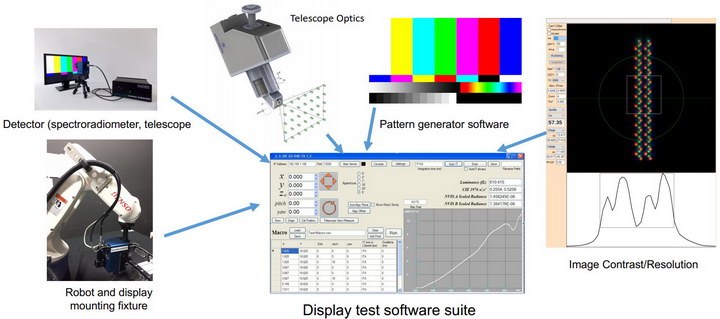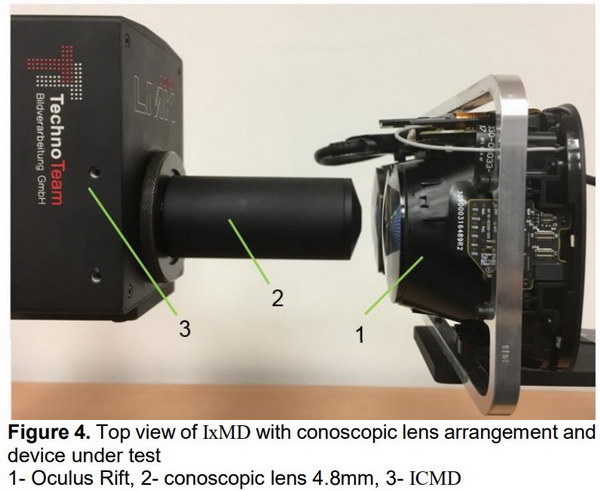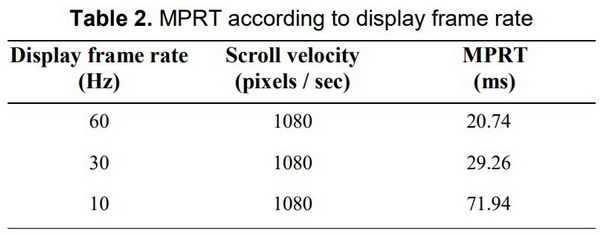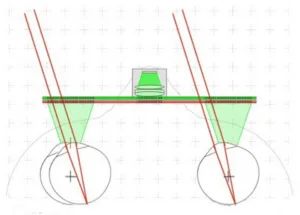Richard Austin, president of Gamma Scientific, and his colleagues at Gamma Scientific presented paper 72-3 titled “Contrast, Resolution and Parallax Measurements of Near to Eye and Head Up Displays” at the symposium but there was no corresponding paper in the Proceedings. Mr. Austin provided me with a Dropbox URL where both the paper and the slides he used can be downloaded. In addition to the paper, I spent some time with Austin in the Gamma Scientific booth discussing measurement of NED displays.
There are a number of properties that need to be measured in the evaluation of a NED or HUD. The ones Austin listed include:
- Luminance uniformity
- Color uniformity
- Field of View (FOV)
- A map of the design eye box volume, AKA the qualified viewing space (QVS)
- Image contrast
- Image resolution
- Parallax between left and right eyes
- Display image virtual distance
- Image distortion in the FOV
- Resolution WRT eye position and direction in the QVS
- Luminance WRT eye position and direction in the QVS
- Response time/flicker detection
- Latency
The left eye illustrates the Pupil Rotation Point (PRP) as used by the IEC NED test methods and the right eye illustrates the Eye Rotation Point (ERP) as used by the ICDM test methods, both relative to the green shaded QVS of the AR glasses. Note that the PRP method rotates the pupil but does not move it laterally. The ERP both rotates the pupil and moves it laterally, identical to the way the pupil in the human eye moves. (Source: SID 2018 paper 72-3)
To measure any of these optical properties of NED or HUD, the pupil of the measuring instrument must be in the same position and the same size as the position and size of the pupil of the human viewer’s eye. Gamma Scientific, Radiant Vision (Minolta), SUSTAR-OPTICS and perhaps others manufacture lenses like this, so the problem is not the availability of the measurement hardware but its correct use. Mr. Austin is working on the SID’s International Committee for Display Metrology (ICDM) on the next version of the Information Display Measurements Standard (IDMS), which will give test methods to evaluate the properties of a NED or HUD. He is also working with the International Electrotechnical Commission (IEC) Technical Committee 110 WG ADH-12, who is also currently circulating a NED measurement standard for comment. Unfortunately, according to Austin, who is co-author of the IDMS method, there is a small discrepancy between the proposed IDMS and the proposed test method of ADH-12 that can produce large errors when measuring NEDs. In the center (i.e. the eye is on-axis) of the NED, both methods should produce the same answer. When the eye rotates in its socket to view the edges of the NED, the IDMS test method has the pupil rotate about the center of the eye, as happens in a real eye. This moves the pupil sideways as well as rotating it. If the NED has a small QVS, and most NEDs do, this can move the pupil out of the eye box, the image will be vignetted and the luminance will be reduced. Probably, the color, contrast and resolution will be affected as well. In the proposed ADH-12 method, the pupil rotates about the center of the pupil, not the center of the eye, and there is no lateral motion of the pupil. Therefore the measurement pupil may remain inside the QVS even though a real eye may partially exit the QVS. Austin is trying to convince the IEC to use the ERP method for its measurements. He told me the ERP method will be used by the IDMS regardless of what the IEC does.
 Gamma Scientific provides a complete suite of tools to evaluate NEDs. (Source: SID 2018 paper 72-3 PowerPoint)
Gamma Scientific provides a complete suite of tools to evaluate NEDs. (Source: SID 2018 paper 72-3 PowerPoint)
In his paper (72-3) Austin discussed not just the methods for evaluating NEDs but the tools Gamma Scientific provides to implement these measurements on prototype or production HMDs. The company provides a complete suite of tools, not just a lens that puts the pupil in the correct measurement position. These tools can be mounted on a small industrial robot provided by Gamma. Programming of the robot can use either the ERP or the PRP method of rotating the pupil.
 (Source: SID 2018 paper 72-1)
(Source: SID 2018 paper 72-1)
Paper 72-1 was titled “Requests to Lenses in Measuring Units Evaluating Near-Eye Displays” and written by Norbert Schuster and his colleagues at Sustar-Optics. The paper discusses the requirements on the lenses needed to evaluate NEDs and the lenses made by SUSTAR-OPTICS that meet these requirements. The discussion included both conventional lenses that measure the spatial uniformity of a display and conoscopic lenses that measure the angular properties of a display at a single point. Both lenses needed to be used on an Imaging Luminance Measuring Device (ILMD) or an Imaging Color Measuring Device (ICMD) with the acronym for both types of instruments IxMD. While he didn’t discuss any specific IxMD, units from Radiant Vision and Gamma Scientific (and perhaps others) were shown at the SID trade show.
 (Source: SID 2018 paper 72-2)
(Source: SID 2018 paper 72-2)
Paper 72-2 was titled “Standardizing Fundamental Criteria for Near Eye Display Optical Measurements: Determining Eye Point Position” and was from Russell Draper and his colleagues at the Cerdec Night Vision Electronic Sensors Directorate, the University of Colorado and NIST. Cerdec is a function of the US Army, which has a special interest in night vision and other NED systems. The importance of the eye point position determination is the eye point must be known in order to accurately measure the optical properties of a NED system and have the measured results correlate with the images perceived by a human viewer. The Army wants its NED suppliers to use a standard method to determine eye point, which will then allow the Army to correlate its measurements with measurements by its suppliers. Four different eye-point determination methods were tested in this investigation: 1) crosshair, 2) center luminance, 3) center resolution, and 4) full field of view methods. All of these methods could determine the eye point location within 1mm but Draper said the full-field luminance method produced the most accurate and repeatable measurements of system luminance and resolution.
 (Source: SID 2018 paper 72-4)
(Source: SID 2018 paper 72-4)
Paper 72-4 titled “Head Movement-based Motion Blur Measurement System for Head Mounted Displays” was written by Keon-Woo Kang and his colleagues at Sogang University and LG Display. This system was designed to measure the MPRT of a HMD with the head tilted. The system included a motion base that simulated natural head motion. The NED and a high speed camera were mounted on the motion base and a MPRT test pattern was displayed on the display. As the motion base tilted and rolled at angular speeds comparable to the motion of a normal human’s head, the camera acquired multiple images that could be integrated to match the human response to motion in order to determine MPRT. To produce test results for the system, the authors used a Sony DSC-RX100M5 high-speed camera and an Oculus Rift DK2 as the target HMD device. The results showed MPRT essentially independent of the motion speed of the test image but strongly dependent on frame rate. Not surprisingly, the lowest frame rate had the highest MPRT and the highest motion blur. –Matthew Brennesholtz

